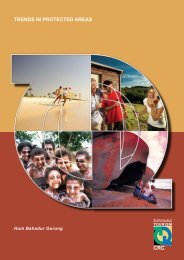icolls - Sustainable Tourism CRC
icolls - Sustainable Tourism CRC
icolls - Sustainable Tourism CRC
Create successful ePaper yourself
Turn your PDF publications into a flip-book with our unique Google optimized e-Paper software.
ECOLOGY, THREATS AND MANAGEMENT OPTIONS FOR SMALL ESTUARIES AND ICOLLS<br />
Effects of entrance opening events (forced and natural) on the ecological structure and<br />
functioning of ICOLLS<br />
ICOLL opening and closing regimes are highly variable under natural conditions (Neira & Potter 1992; Pollard<br />
1994a; Young et al. 1997; Bell, Cowley & Whitfield 2001; Cowley, Whitfield & Bell 2001; Griffiths 2001; Roy<br />
et al. 2001; Young & Potter 2002). Due to this variability, ICOLLs along the south-eastern coast of Australia<br />
persist along a continuum: some behave like macrotidal estuaries (normally open to the ocean), others open once<br />
or twice a year and others remain almost permanently closed (Pollard 1994a; Roy et al. 2001). The factors that<br />
influence the status of an ICOLL (in terms of its opening regime) are also variable, as they depend upon<br />
orientation, local weather patterns, catchment size and the management strategies employed by the local councils<br />
(Roy et al. 2001).<br />
Rainfall-initiated berm breaches<br />
Under natural conditions, most ICOLLs along the east coast of Australia open in response to prevailing weather<br />
conditions (Pollard 1994a; Roy et al. 2001). In many areas, extensive and/or prolonged precipitation events<br />
trigger opening (Pollard 1994a; Roy et al. 2001; Froneman 2002; Young & Potter 2002). This rainfall-initiated<br />
method of berm breaching is most common in northern parts of Australia, where seasonal rainfall is high and<br />
catchments are smaller (Roy et al. 2001). In addition to re-establishing marine connectance, increased freshwater<br />
flows can alter the physico-chemical characteristics of the system (Roy et al. 2001). Rainfall-initiated berm<br />
breaches are rarely maintained for long periods of time, due to short duration of high rainfall events and the<br />
sedimentation associated with increased terrestrial and marine inputs during the period of opening (Pollard<br />
1994a; Young et al. 1997; Griffiths 2001).<br />
The effects of rainfall-initiated berm breaching on ICOLL ecology generally relate to the consequent<br />
increases in terrestrial inputs to the system, including the accelerated delivery and/or excessive provision of<br />
nutrients and allochthonous organic matter (Ardisson & Bourget 1997; Verlaan, Donze & Kuik 1998; Loneragan<br />
& Bunn 1999; Pinay, Clement & Naiman 2002). In addition, increased freshwater discharge has been shown to<br />
influence patterns of fish species migration (Neira & Potter 1992; Pollard 1994b; Young et al. 1997; Bell,<br />
Cowley & Whitfield 2001; Bunn & Arthington 2002; Griffiths 2001; Young & Potter 2002). Whilst adults tend<br />
to leave ICOLLs during periods of opening, postflexion larvae migrate into these nursery areas, principally<br />
mangrove and seagrass beds (Neira & Potter 1992; Young et al. 1997; Bell, Cowley & Whitfield 2001; Griffiths<br />
2001; Young & Potter 2002). In addition, resident fish species may add to the planktonic diversity and biomass<br />
through their spawning activities, which are often triggered by changes in salinity during periods of increased<br />
freshwater discharge (Bell, Cowley & Whitfield 2001; Bunn, Loneragan & Yeates 1998; Chanton & Lewis<br />
2002).<br />
Marine overwashing<br />
Marine overwashing is another mechanism by which ICOLLs can regain their hydrologic connection with the<br />
ocean (Bell, Cowley & Whitfield 2001; Roy et al. 2001). Marine overwashing typically occurs when high tides,<br />
storms and/or strong winds lead to the overtopping of berms with seawater (Bell, Cowley & Whitfield 2001;<br />
Cowley, Whitfield & Bell 2001; Roy et al. 2001). Working in ICOLLs in South Africa, Bell et al. (2001) found<br />
that marine overwashing was a much more frequent cause of ICOLL opening than rainfall events, although these<br />
openings were of much shorter duration. In contrast, Roy et al. (2001) classified south-eastern Australian<br />
systems prone to marine overwashing as wave-dominated estuaries, where consistent wave action can maintain<br />
opening regimes on the order of several months.<br />
Once open, wave-dominated ICOLLs can receive considerable quantities of marine inputs (Roy et al. 2001)<br />
and it is possible that during these periods of marine connectance, the importance of terrestrial sources of<br />
nutrients and organic matter to ICOLL consumers may be significantly reduced. The consequences of increased<br />
marine contribution to coastal systems have received considerable attention in recent years. For example,<br />
Jonsson and Jonsson (2003) found that migratory salmon can deliver significant quantities of marine-derived<br />
carbon and nitrogen to streams and rivers, thus significantly subsidising nutrient and energy processing pathways<br />
in inland freshwater systems. These mechanisms of energy and nutrient subsidy and their importance in ICOLL<br />
ecosystems have not been fully investigated.<br />
Artificial opening<br />
As mentioned above, the artificial opening of ICOLLs has long been utilised as a management tool for flushing<br />
purposes (removing excessive algal biomass) and/or flood abatement (Pollard 1994a; Roy et al. 2001). However,<br />
the ecological consequences of forced openings have not been fully investigated, apart from instances in which<br />
actions have led to ecological disasters such as significant fish kills (Pollard 1994a). Considerable research effort<br />
9











